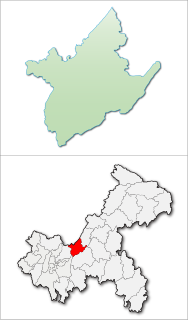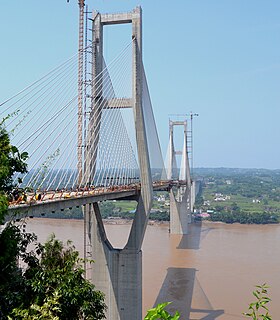
Chongqing, alternately romanized as Chungking, is a municipality in southwest China.

Fuling is a district in the geographical center of Chongqing Municipality, China.

Nan'an District, is one of the six central districts of Chongqing municipality, China. It covers an area of 262.43 km2, with 44 km2 covered with forests and woods. It has an estimated population of 891,000 in late 2017.

Changshou is a district in Chongqing, China, located by the Yangtze river, with a history spanning several thousand years. Changshou is 80 km (50 mi) from the Yuzhong District of downtown Chongqing.

Zhong County or Zhongxian is a county of Chongqing Municipality, China.

Wanxian Bridge, or Wanzhou Bridge, is a reinforced concrete arch bridge built over the Yangtze River in 1997. It is located in the vicinity of the Three Gorges Dam in Wanzhou, Chongqing, China. The arch span is 420 metres (1,380 ft) and the total length of the bridge is 864.12 metres (2,835.0 ft). The clearance height to the river below is 133 metres (436 ft) however the full clearance is no longer visible as the reservoir created by the construction of the Three Gorges Dam has increased the height of the water. During the bridge construction, a concrete-filled tubular arch truss frame was built to support the weight of the concrete arch and embedded into the concrete arch.

The Wu River is the largest southern tributary of the Yangtze River. Nearly its entire length of 1,150 kilometres (710 mi) runs within the isolated, mountainous and ethnically diverse province of Guizhou. The river takes drainage from a 80,300-square-kilometre (31,000 sq mi) watershed.

The bridges and tunnels across the Yangtze River carry rail and road traffic across China's longest and largest river and form a vital part of the country's transportation infrastructure. The river bisects China proper from west to east, and every major north-south bound highway and railway must cross the Yangtze. Large urban centers along the river such as Chongqing, Wuhan, and Nanjing also have urban mass transit rail lines crossing the Yangtze.

The Shanghai–Chongqing Expressway, commonly referred to as the Huyu Expressway is an east-west bound expressway that connects the cities of Shanghai, China in Yangtze River Delta, and Chongqing in western China. The expressway runs through six provinces/municipalities and adjoin major cities such as Wuhu, Anqing, Wuhan and Yichang, roughly parallel to G42 Shanghai-Chengdu Expressway to its south. The thoroughfare begins at Huqingping Outer Ring Interchange near Hongqiao International Airport, where it meets S20 Outer Ring Expressway in Shanghai, and terminates at an interchange in Jiangbei District, where the highway joins G75 Lanzhou-Haikou Expressway. It is fully complete and spans 1,900 km (1,200 mi) in length.

The Zhongxian Yangtze River Bridge is a suspension bridge over the Yangtze River in Zhong County of Chongqing, China. Completed in 2001, the bridge has a total length 1,199.73 metres (3,936.1 ft) including a longest span of 560 metres (1,840 ft), which places the bridge among the longest suspension spans in the world. In 2006, the bridge received the Lu Ban Award for engineering excellence.

The Zhongzhou Yangtze River Bridge is a cable-stayed bridge over the Yangtze River in Zhong County of Chongqing, China. Completed in 2009, the bridge carries traffic on the G50 Shanghai–Chongqing Expressway.

The Meixi River Bridge is an arch bridge which crosses the Meixi River in Fengjie, Chongqing, China. It replaced an earlier suspension bridge across the river built in 1990. Completed in 2000, The bridge was constructed 140 metres (460 ft) above the river however the reservoir created by the construction of the Three Gorges Dam has increased the height of the water below the bridge and the full clearance is no longer visible. The bridge spans 288 metres (945 ft) ranking among the longest arch bridges in the world. The bridge is located very near the end of the river and can be seen by boats travelling along the Yangtze River.

The Hanjiatuo Yangtze River Bridge is a cable-stayed railway bridge over the Yangtze River in the Fuling District of Chongqing, China. The bridge carries the Chongqing-Lichuan Railway and was completed in 2012.

Fuling Wujiang Bridge is a cable-stayed bridge in Fuling, Chongqing, China. The bridge spans 340 metres (1,120 ft) over the Wu River very near its confluence with the Yangtze river. Completed in 2009 the bridge was the second over the Wu River in Fuling after the Fuling Arch Bridge that was completed in 1989. The bridge contains a partial cloverleaf interchange on the western side of the river.

The Changshou Yangtze River Bridge is a cable-stayed bridge over the Yangtze River in the Changshou District of Chongqing, China.

The Changshou Yangtze River Railway Bridge is a railway truss bridge over the Yangtze River in Changshou District, Chongqing, China. The bridge was completed in 2005 and carries two track of the Chongqing–Huaihua Railway. The bridge is 898.36 metres (2,947.4 ft) long. The bridge won the 2008 Lu Ban award for excellence in engineering.

The Kangbo Yangtze River Bridge, was called Second Hejiang Bridge, is a highway bridge over the Yangtze River in Hejiang County, Sichuan, China. The bridge is on the G93 Chengdu–Chongqing Ring Expressway just 10 kilometres west of the Bosideng Bridge. It was originally called Hejiang Bridge 2 since Bosideng Bridge was first called Hejiang Bridge 1. The bridge has a length of 1,715 metres (5,627 ft) and is 30 metres (98 ft) wide. Its two pylons are each 208 metres (682 ft) heigh making the bridge to the one with the highest pylons in Sichuan.

The Baiheliang Underwater Museum or White Crane Ridge Underwater Museum is an underwater museum built around the White Crane Ridge of Fuling District, Chongqing. It is China's first underwater museum.
Twelve Views of Bayu are popular scenic views in and around the city of Chongqing, China. Ba and Yu are old names of Chongqing in Imperial times. Influenced by Eight Views of Xiaoxiang in Hunan Province, people in Chongqing listed their own most beloved views during the reign of Tianshun Emperor of Ming Dynasty. Scenic views in the list changed throughout the history. Some scenic views appeared in earlier lists no longer exist in modern days due to the change of physical geography, landscapes and land-uses.




















